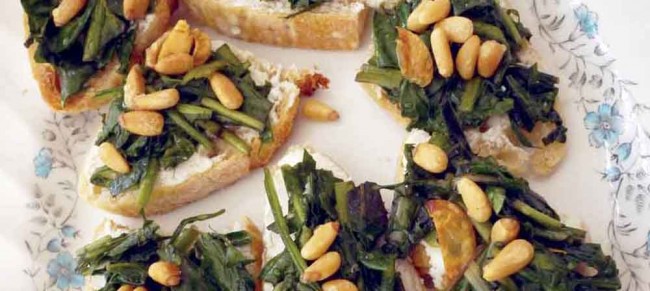
Dandelions: An underrated northern delicacy
The dandelion is a plant that gives and gives, from the moment its green spiky leaves first appear in early spring, right up until fall when the seed head has blown and the leaves have become tough and leathery. Even then a rogue flower sometimes appears in a damp meadow or a shady corner of the yard.
In fact, some might say the dandelion is excessively prolific—especially those who love an unblemished lawn. A neighbour around the corner despises the dandelion so much that she paved her lawn and turned it into a parking lot.
Though underappreciated in North America, the dandelion is much admired in Europe and Asia. Its health-giving properties are legend: the leaves are packed with vitamins K and A and contain substantial amounts of C and B6, as well as thiamine, riboflavin, calcium and iron. They are also high in fibre. Current research suggests that dandelion root extract may even be helpful in the treatment of leukemia.
The whole dandelion plant can be eaten; roots are best harvested in spring and fall, crowns and greens before the plant flowers, and flowers as soon as they, well, flower. Young greens don’t need blanching, although older greens might as the bitter flavour (so loved in many cultures) becomes more pronounced.
Sign of spring
I first learned about dandelions when I lived in Greece in the early ’80s. Greek for dandelion is pikralida, meaning “bitter” and referring to the plant’s bracing bite. We picked them on the rocky shore or under prickly bushes in October after the first rains, and served them boiled hard, drained and doused in olive oil and lemon. This is still one of my favourite ways to eat dandelion greens.
In the Yukon, spring dandelions are the first edible green to appear, telling us the long winter is over and soon we’ll be harvesting other greens and herbs. The faithful dandelion will be with us until the snow falls again.
One of the interesting things about foraging is that we often get advice about when to pick a wild ingredient, but not always how. I learned by trial and error, for example, that well-established dandelion roots can be a tangled mass with dirt and vegetation packed within, making cleaning difficult and the yield small. I tend to avoid the older, bushier plants when harvesting roots. As well, the interior of a dandelion root can become woody, like that of an old carrot. The woody part is a dull, ivory colour, whereas the newer part looks white and juicy. This is what you want.
For roasted dandelion root, wash roots, peel them and cut away any woody bits, then cut into chunks and grind in a food processor until the roots resemble coarse sand. Spread ground roots on a baking sheet lined with parchment paper and roast at 200 F (95 C) until browned and aromatic, about two hours. Cool and store in glass jars. Leave as is for making coffee or tea, or grind down further into powder for use as a seasoning for crème brulée or other sweet concoctions.
To pick dandelion greens, choose your spot well: avoid roadsides, cut lines, lawns or parks that might have been sprayed with pesticides, and ask for permission to pick on private property. The easiest way to extract them from the ground is to grasp the leaves where they meet in a crown near the root, pull slightly and cut just underneath the crown, keeping the plant in one piece. Sometimes several plants are packed tightly together; then you’ll need to dig with your fingers to discover where each crown emerges from the root. Sometimes you can free a number of plants with one cut.
Once cooked, the leaves collapse against the stems, whose texture is like al dente spaghetti. In Greece, we loved this. We simply twirled the stringy greens around our forks. But for bruschetta it’s best to chop the greens either before or after they’re cooked.
Crown jewels
I used to throw dandelion crowns away, then I read John McPhee’s classic New Yorker account of a fall foraging expedition with Euell Gibbons in the Appalachian Mountains along the Susquehanna River. For the first few days they ate only what they could gather from the wild. Dandelion crowns were a frequent menu item, and Gibbons and McPhee considered them a delicacy, even moreso later in the trip when they started adding things like salt and fat back into their diet.
Dandelion crowns require a lot of cleaning and sorting, which adds to their appeal when they are finally cooked and on the table: you’ve worked for that treat. I find them reminiscent of artichoke hearts, but more subtle. Sometimes there are a few tightly curled buds in the crowns, adding another dimension of flavour.
I should add that my husband, Hector, is underwhelmed by dandelions. Fair enough; wild greens don’t appeal to everyone. But before you pull out the weed-whacker this summer, give dandelions a chance, and try cooking them in small batches. They could become your new best friend.
Dandelion & Chèvre Bruschetta
1 lb (455 gr) dandelion leaves
1/3 cup (80 mL) pine nuts
4 cloves garlic
1 Tbsp (15 mL) olive oil
1 baguette, sliced into 24 thin slices
1 Tbsp (15 mL) olive oil
4½ oz (130 gr) chèvre
1 Tbsp (15 mL) fireweed honey (or substitute other wildflower honey)
Clean the root end of each plant with a knife, removing all black or brown until the base shows white. Cut the leaves off about one inch above the crown, leaving the crown intact. Put crowns to soak in cold water and reserve to make grilled dandelion crowns (see recipe, page …)
Wash leaves several times, lifting them into a strainer and emptying the water from the bowl each time; continue until there’s no dirt residue left in the bowl. Shake leaves dry, chop coarsely and reserve. (If you’ve bought dandelion leaves from the market, they’re usually detached from the crown and fairly clean, needing just a rinse and a shake dry.)
Toast pine nuts in a dry cast iron plan over medium-low heat until golden. Peel garlic and slice thinly lengthwise. Heat olive oil in the same pan over low to medium-low heat; sauté garlic slices until crisp and just beginning to brown (five or six minutes), remove from heat and drain on paper towel.
In the same oil, sauté dandelion greens until wilted, about five minutes. Toast baguette slices under the broiler, about one minute per side. Brush one side with spruce tip oil and spread with chèvre. Pile dandelion greens over chèvre, arranging three to four garlic slices on top. Sprinkle with pine nuts and drizzle with honey. Serve at once.
Makes 24 bruschetta
Grilled Dandelion Crowns
30-40 dandelion crowns
Olive oil
Salt and pepper
One lemon, quartered
Trim dandelion crowns and wash them several times. Pat dry in a tea towel. Toss with olive oil and sprinkle with salt and pepper. Grill on the barbecue on a piece of tinfoil or in a grilling basket over medium heat until wilted, about seven minutes. Serve warm or at room temperature with a squeeze of lemon over top.
Makes eight servings of three to four crowns each.





